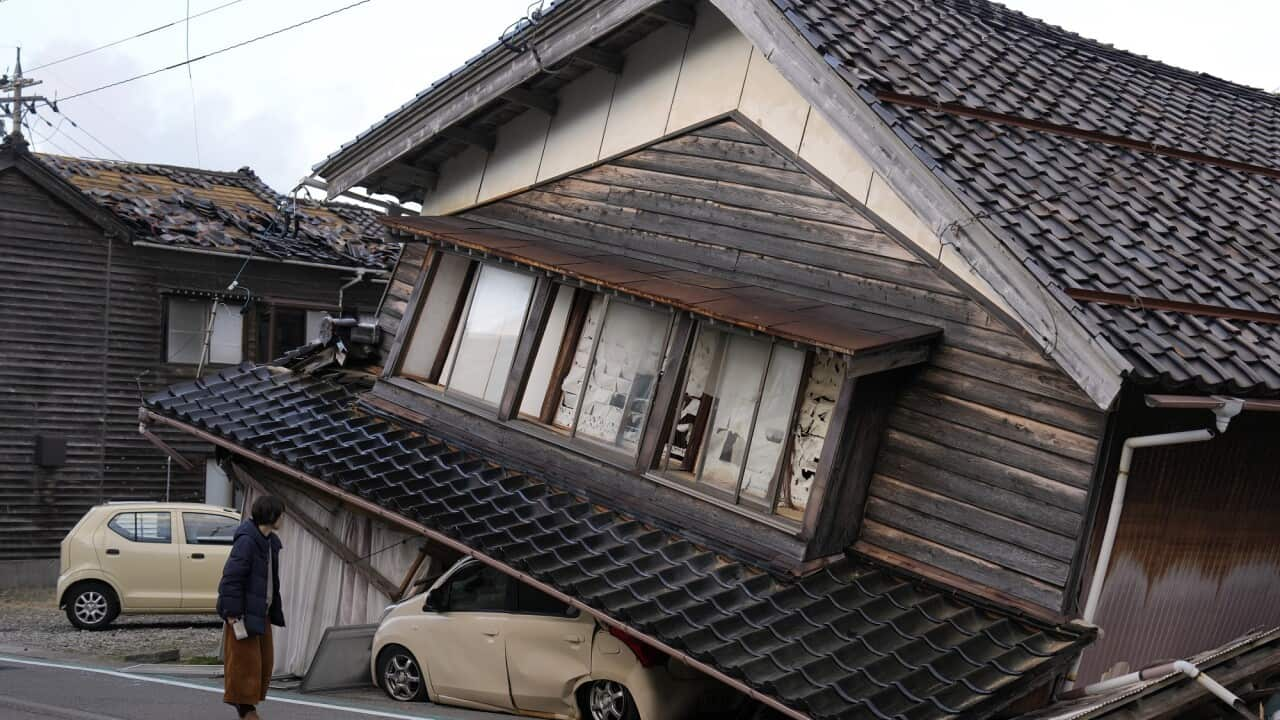Key Points
- A powerful earthquake has hit Japan, resulting in around 200 tremors in the aftermath.
- In some places, 90 per cent of houses have been destroyed.
- Some 3,000 rescuers are working hard to rescue survivors trapped under collapsed buildings.
Japanese rescuers have scrambled to search for survivors as authorities warned of landslides and heavy rain after a powerful earthquake that killed at least 62 people.
The 7.5-magnitude quake that rattled Ishikawa prefecture on the main island of Honshu is the deadliest since 2016. The disaster triggered tsunami waves more than a metre high, sparked a major fire and tore apart roads.
On the Noto Peninsula, the destruction included buildings damaged by fire, houses flattened, fishing boats sunk or washed ashore, and highways hit by landslides.
The regional government announced on Wednesday that 62 people had been confirmed dead and more than 300 injured, 20 of them seriously.
"I'm amazed the house is this broken and everyone in my family managed to come out of it unscathed," said Akiko, standing outside her parents' tilting home in the badly hit city of Wajima.
The way 2024 started "will be etched into my memory forever", she told AFP after what she called the long and violent earthquake on Monday.
"It was such a powerful jolt," Tsugumasa Mihara, 73, said as he queued with hundreds of others for water in the nearby town of Shika.
"Very extensive damage has been confirmed, including numerous casualties, building collapses and fires," Prime Minister Fumio Kishida said after a disaster response meeting.
'Race against time'
"We have to race against time to search for and rescue victims of the disaster."
Aerial news footage showed the terrifying scale of a fire that ripped through the old market area of Wajima, where a seven-storey commercial building collapsed. Quake damage impaired rescue efforts to put out the blaze.
Most of the houses in the coastal city of Suzu collapsed, according officials cited by Kyodo.
"The situation is devastating, as about 90 percent of houses have been completely or nearly completely destroyed," Suzu Mayor Masuhiro Izumiya was reported as saying at a prefectural government meeting.
Almost 33,000 households were without power in the region, which saw temperatures touch freezing overnight, the local energy provider said. Many cities were without running water.
The US Geological Survey said the quake had a magnitude of 7.5. Japan's meteorological agency measured it at 7.6, and said it was one of more than 210 to shake the region through Tuesday evening.
Several strong jolts were felt early Tuesday, including one measuring 5.6 that prompted national broadcaster NHK to switch to a special programme.
"Please take deep breaths," the presenter said, reminding viewers to check for fires in their kitchens.
Tsunami warning lifted
On Monday, waves at least 1.2 metres high hit Wajima and a series of smaller tsunamis were reported elsewhere.
Warnings of much larger waves proved unfounded and on Tuesday, Japan lifted all tsunami warnings.
Images on social media showed cars, houses and bridges in Ishikawa wobbling violently as terrified people cowered in shops and train stations.
Houses collapsed and huge cracks appeared in roads while others were hit by landslides. Forecasters warned that rains could further loosen soil on hillsides.

People walk past collapsed buildings following an earthquake in Wajima, Ishikawa prefecture, Japan. A series of powerful earthquakes in western Japan damaged homes, cars and boats. Source: AAP / ñÓìáêíãM/AP
Suzu's mayor called the damage in the city "catastrophic" and said 1,000 houses had been completely destroyed there, with 4,000 to 5,000 residents unable to live in their homes, according to local media.
The quake also comes at a sensitive time for Japan's nuclear industry, which has faced fierce opposition since a 2011 earthquake and tsunami triggered nuclear meltdowns in Fukushima on the eastern coast. Whole towns were devastated and nearly 20,000 people were killed.
Japan last week lifted an operational ban imposed on the world's biggest nuclear plant, Kashiwazaki-Kariwa, which has been offline since the 2011 tsunami.
The Nuclear Regulation Authority said no irregularities were found at nuclear plants along the Sea of Japan, including five active reactors at Kansai Electric Power’s Ohi and Takahama plants in Fukui Prefecture.
Additional reporting by Reuters










